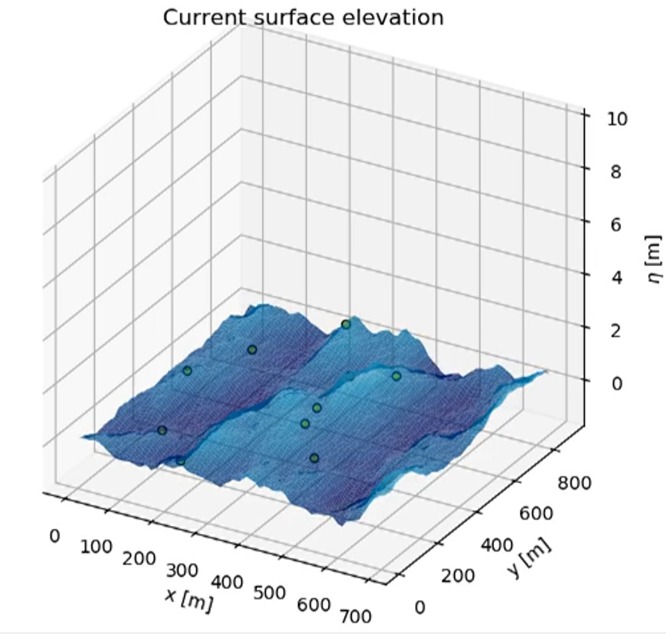Intelligent Wave Power: Advance Optimization and Survivability of CETO Multi-moored System
The ocean is a challenging environment to deploy, operate and maintain equipment in, in particular, Wave Energy Converters (WECs) must survive a range of wave conditions resulting in high costs. This Project aims to develop an advanced control system for Carnegie’s CETO Wave Energy Converter, enabling reduced capital and operational costs whilst increasing power capture and maintaining safety.
Area of science
Computational Fluid Dynamics, Energy, Energy Systems Engineering, Ocean Engineering, Renewable Power
Systems used
Magnus and Zeus
Applications used
OpenFoam / Naval Hydro Pack / SWASH / Custom Pyhton codes (Keras, Scikit Learn, etc…)The Challenge
WECs are subjected to ocean conditions and interact with oncoming waves. These systems must be designed to cope with any response that may occur during the worst expected sea state, resulting in systems which are overdesigned for most operational conditions, and therefore costs which are disproportionate to the value the system may produce.
WECs rely applying the correct Power Take Off (PTO) control force that maximises the amount of power absorbed by the system in production conditions and minimise extreme responses during storms. Although there is natural variability in successive waves hitting the device, current controllers rely on hourly to half-hourly average values of the wave height and period to perform this task, which means that the controller cannot anticipate and react to optimise the devices’ response to individual waves, be it to increase power output or protect the device during storms.
Advanced controllers optimise the PTO force on a wave-by-wave basis. They are required to predict the interaction between waves and WEC in real time, with high fidelity across all sea states. The high computational cost of such operations has hindered the development of active controllers so far. Current modelling techniques take days of supercomputer processing to generate minutes of simulation and the ability of current modelling methods to calculate these interactions at something approaching real-time will require the next generation of supercomputers. As a result, WEC control systems currently are based upon limited Computational Fluid Dynamics (CFD) and empirical results derived from model scale testing where the optimal control force for a given sea state is determined.
The Solution
Machine Learning (ML) offers the potential to compute wave-structure interaction in a fraction of the time required to solve the equations governing the problem, simply by observing and learning the physics. Such ML tools are an enabler for WEC advanced controllers. This project aims to develop and validate machine learning tools able to compute wave propagation and wave-structure interaction in real time, with the fidelity level of RANS physics based software packages such as openFOAM. Real time computation of wave propagation allows to predict waves which will hit the CETO system up to thirty seconds into the future, which in turn allows to predict hydrodynamic forces acting on the system in the future, also in real time. This information can then be used by the controller to optimise the PTO force on a wave by wave basis. These tools will be integrated in the design of the CETO WEC and deployed in the next generation of the technology. This will enable a 35% increase in power output, as well as a cost reduction due to reduction of extreme response during storms, resulting in an overall reduction in Levelised Cost of Energy in the range of 30%.
The Outcome
Though ML tools unlock a significant speedup for online CFD computation, they require heavy offline training. Whether it be to model wave propagation or fluid structure interaction, the training set has to cover the range of sea states expected to occur at the WEC deployment location. In addition, it has to contain a sufficient amount of data for each sea state to allow the ML model meet industrial control accuracy and reliability requirements. The Pawsey supercomputers are key to the success of this project. Magnus allowed the team to generate a large amount of high-fidelity data using both SWASH (for wave propagation), and openFOAM (for fluid-structure interaction). Zeus enabled fast prototyping of ML models, by allowing to load large datasets in memory and parallel-training of several models. Though the project suffered some delays last year due to Carnegie Clean Energy (CCE) going into voluntary administration, CCE is now out of administration the team has made significant progress through the last two quarters, with a successful design or a ML wave predicting tool, which will be presented in a paper in 2020.
List of Publications
Rafiee, A., and Fiévez, J., “Numerical Prediction of Extreme Loads on CETO Wave Energy Converter”, In: Proceedings of EWTEC 2015, The 11th European Wave and Tidal Energy Conference, Nantes, France 2015.
Rafiee, Ashkan & Valizadeh, Alireza. (2018). Non-Linear Hydrodynamics of Bluff Bodies Oscillating Near Free-Surface
Rafiee, A., Wolgamot, H., Draper, S., Orszaghova, J., Fiévez, J., and Sawyer, T., “Identifying the design wave group for the extreme response of a point absorber wave energy converter”, In: Proceedings of AWTEC 2016, The 3rd Asian Wave and Tidal Energy Conference, Singapore 2016

Figure 1: Vorticity field around the BA of the CETO system







